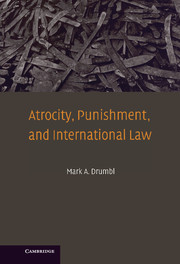Book contents
- Frontmatter
- Contents
- Preface and Acknowledgments
- List of Abbreviations
- Atrocity, Punishment, and International Law
- 1 Extraordinary Crime and Ordinary Punishment: An Overview
- 2 Conformity and Deviance
- 3 Punishment of International Crimes in International Criminal Tribunals
- 4 Punishment of International Crimes in National and Local Criminal Justice Institutions
- 5 Legal Mimicry
- 6 Quest for Purpose
- 7 From Law to Justice
- 8 Conclusion: Some Immediate Implications
- Notes
- Index
7 - From Law to Justice
Published online by Cambridge University Press: 03 December 2009
- Frontmatter
- Contents
- Preface and Acknowledgments
- List of Abbreviations
- Atrocity, Punishment, and International Law
- 1 Extraordinary Crime and Ordinary Punishment: An Overview
- 2 Conformity and Deviance
- 3 Punishment of International Crimes in International Criminal Tribunals
- 4 Punishment of International Crimes in National and Local Criminal Justice Institutions
- 5 Legal Mimicry
- 6 Quest for Purpose
- 7 From Law to Justice
- 8 Conclusion: Some Immediate Implications
- Notes
- Index
Summary
In this chapter, I outline two proposals. These proposals begin a conversation. They do not seal a conclusion. The proposals respond to two major, and interconnected, shortcomings of dominant modalities of prosecution and incarceration: (1) the democratic deficits and externalization of justice that they trigger; and (2) the difficulties they experience in attaining stated penological objectives.
The two proposals, which I present as reforms, are: (1) vertical: to rescript the division of labor toward greater inclusiveness of in situ sociolegal institutions and bottom-up input; and (2) horizontal: to look beyond criminal process and welcome the general regulatory power of law, as well as extralegal interventions, to holistically capture the broad-based complicity that inheres in mass atrocity.
These two reforms are synergistic. When twinned, they promote a pluralistic understanding of accountability; their goal is to activate a broader sense of justice in the aftermath of atrocity. These reforms aim to move the agenda from law to justice: initially, by advancing international criminal law to a capacious law of atrocity and, ultimately, to an enterprise that constructively incorporates extrajudicial initiatives.
Of course, international criminal law as currently implemented through prosecution and incarceration goes some way to promote justice. But it is intrinsically limited. A richly multivalent approach could go further. It could push penological objectives, for instance reintegration and restoration, which heretofore have been given short shrift.
- Type
- Chapter
- Information
- Atrocity, Punishment, and International Law , pp. 181 - 205Publisher: Cambridge University PressPrint publication year: 2007

